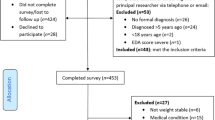Abstract
The aim of the study was to determine the prevalence of orthorexia nervosa among the performance artists in the State Opera and Ballet and in the Bilkent University Symphony Orchestra. The study population consisted of 39 men and 55 women for a total of 94 artists with mean age of 33 years. The ORTO-15 test was used to determine the prevalence of orthorexia nervosa. Those subjects who scored below 40 in the ORTO-15 test were classified as having orthorexia nervosa. Mean score of the participants in the ORTO-15 test was 37.9±4.46. A total of 56.4% of the artists involved in the research scored below 40 in the ORTO-15 test. While the highest prevalence of orthorexia nervosa was recorded among opera singers (81.8%), it was 32.1% among ballet dancers and 36.4% among symphony orchestra musicians. The differences between the three groups were statistically significant. No difference was noted between mean ORTO-15 score by baseline characteristics as gender, age, educational level, work experience, body mass index, smoking and alcohol consumption. The research group have a higher socio-economic and education level than the majority of the general public in Turkey. Additionally, being an artist in Turkey means being a role model for the general public both in terms one’s physical appearance and lifestyle. These may be the reason why artists are more sensitive to this issue.
Similar content being viewed by others
References
Bratman S., Knight D.: Health food junkies: Orthorexia nervosa: Overcoming the obsession with healthful eating. 1st edition. New York, Broadway, 2001.
Donini L.M., Marsili D., Graziani M.P., Imbriale M., Cannella C.: Ortorexia nervosa: A preliminary study with a proposal for diagnosis and attempt to measure the dimension of the phenomenon. Eat. Weight Disord., 9, 151–157, 2004.
Mathieu J.: What is orthorexia? J. Am. Diet. Assoc., 105, 1510–1512, 2005.
American Psychiatric Association. Diagnostic and statistical manual of mental disorders. 4th edition. Washington, DC, American Psychiatric Association, 1994.
Catalina Zamora M.L., Bote Bonaechea B., Garcia Sanchez F., Rios Rial B.: Ortorexia nervosa. A new eating disorder? Actas. Esp. Siquatr., 33, 66–68, 2005.
Eriksson L., Baigi B., Marklund E., Lindgren E.C.: Social physique anxiety and sociocultural attitudes toward appearance impact on orthorexia test in fitness participants. Scand. J.Med. Sci. Sports, 18, 389–394, 2008.
Arusoğlu G.: Examination of healthy nutrition obsession (orthorexia), adaptation of ORTO-15 test. Ankara, Hacettepe University, Institute of Health Science, Nutrition and Dietetics Program Dissertation of Science Specialty, 2006.
Bosi Bagğci A.T., Çamur D., Güler Ç.: Prevalence of orthorexia nervosa in resident medical doctors in the faculty of medicine (Ankara, Turkey). Appetite, 49, 661–666, 2007.
Donini L.M., Marsili D., Graziani M.P., Imbriale M., Cannella C.: Ortorexia nervosa: validation of a diagnosis questionnaire. Eat.Weight Disord., 10, e28–e32, 2005.
World Healt Organization. (2006) BMI classification. http://www.who.int/bmi/index.jsp?intropage=intro_3.html. Accessed: March 2008.
Abraham S.: Characteristics of eating disorders among young ballet dancers. Psychopathology, 29, 223–229, 1996.
Ravaldi C., Vannacci A., Zucchi T., Mannucci E., Cabras P.L., Boldrini M., Murciano L., Rotella C.M., Ricca V.: Eating disorders and body image disturbances among ballet dancers, gymnasium users and body builders. Psychopathology, 36, 247–254, 2003.
Ravaldi C., Vannacci A., Bolognesi E., Mancini S., Faravelli C., Ricca V.: Gender role, eating disorder symptoms, and body image concern in ballet dancers. J. Psychosom. Res., 61, 529–535, 2006.
Author information
Authors and Affiliations
Corresponding author
Rights and permissions
About this article
Cite this article
Aksoydan, E., Camci, N. Prevalence of orthorexia nervosa among Turkish performance artists. Eat Weight Disord 14, 33–37 (2009). https://doi.org/10.1007/BF03327792
Received:
Accepted:
Published:
Issue Date:
DOI: https://doi.org/10.1007/BF03327792



